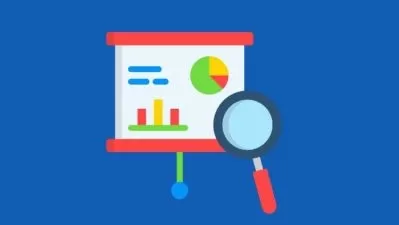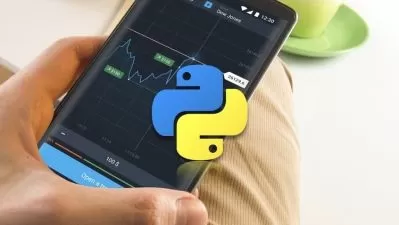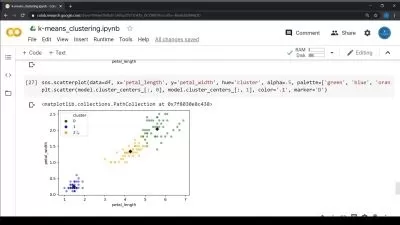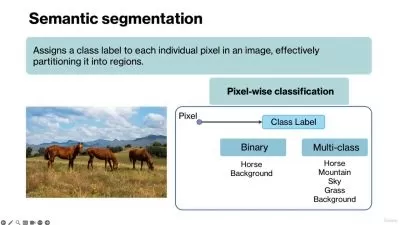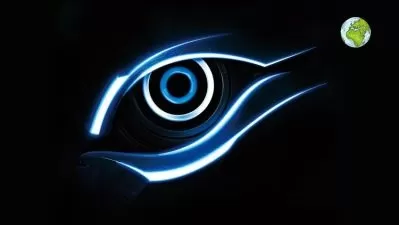Modern Computer Vision & Deep Learning with Python & PyTorch
Computer Science & AI School,Mazhar Hussain
6:41:51
Description
Computer Vision with Python using Deep Learning for Classification, Instance & Semantic Segmentation, & Object Detection
What You'll Learn?
- Learn Computer Vision and Deep Learning with Real-world Applications in Python
- Learn Deep Convolutional Neural Networks (CNN) for Computer Vision
- Computer Vision for Single and Multi-label Classification with Python and Pytorch
- Computer Vision for Image Semantic Segmentation with Python and Pytorch
- Computer Vision for Image Instance Segmentation with Python and Pytorch
- Computer Vision for Object Detection with Python and Pytorch
- Google Colab with GPU for Writing Python and Pytorch Code
- Learn Data Augmentation with Different Image Transformations
- Custom Datasets for Image Classification, Image Segmentation and Object Detection
- Hyperparameters Optimization of Deep Learning Models to Improve Performance
- Learn Performance Metrics (Accuracy, IOU, Precision, Recall, Fscore)
- Transfer Learning with Pretrained Models of Deep Learning in Pytorch
- Train Image Segmentation, Classification and Object Detection Models on Custom Datasets
- Evaluate and Deploy Image Segmentation, Image Classification and Object Detection Models
- Object Detection using Detectron2 Models Introduced by Facebook Artificial Intelligence Research (FAIR) Group
- Perform Object Detection using RCNN, Fast RCNN, Faster RCNN Models with Python and Pytorch
- Perform Semantic Segmentation with UNet, PSPNet, DeepLab, PAN, and UNet++ Models with Pytoch and Python
- Perform Instance Segmentation using Mask RCNN on Custom Dataset with Pytorch and Python
- Perform Image Single and Multi-label Classification using Deep Learning Models (ResNet, AlexNet) with Pytorch and Python
- Visualization of Results, Datasets, and Complete Python/Pytorch Code is Provided for Classification, Segmentation, and Object Detection
Who is this for?
What You Need to Know?
More details
DescriptionWelcome to the course "Modern Computer Vision & Deep Learning with Python & PyTorch"! Imagine being able to teach computers to see just like humans. Computer Vision is a type of artificial intelligence (AI) that enables computers and machines to see the visual world, just like the way humans see and understand their environment. Artificial intelligence (AI) enables computers to think, where Computer Vision enables computers to see, observe and interpret. This course is particularly designed to provide a comprehensive, hands-on experience in applying Deep Learning techniques to major Computer Vision problems including Image Classification, Semantic Segmentation, Instance Segmentation, and Object Detection. In this course, you'll start with an introduction to the basics of Computer Vision and Deep Learning, and learn how to implement, train, test, evaluate and deploy your own models using Python and PyTorch for Image Classification, Image Segmentation, and Object Detection.
Computer Vision plays a vital role in the development of autonomous vehicles. It enables the vehicle to perceive and understand its surroundings to detect and classify various objects in the environment, such as pedestrians, vehicles, traffic signs, and obstacles. This helps to make informed decisions for safe and efficient vehicle navigation. Computer Vision is used for Surveillance and Security using drones to track suspicious activities, intruders, and objects of interest. It enables real-time monitoring and threat detection in public spaces, airports, banks, and other security-sensitive areas. Today Computer Vision applications in our daily life are very common including Face Detection in cameras and cell phones, logging in to devices with fingerprints and face recognition, interactive games, MRI, CT scans, image guided surgery and much more. This comprehensive course is especially designed to give you hands-on experience using Python and Pytorch coding to build, train, test and deploy your own models for major Computer Vision problems including Image Classification, Image Segmentation (Semantic Segmentation and Instance Segmentation), and Object Detection. So, are you ready to unleash the power of Computer Vision and Deep Learning with Python and PyTorch:
Master the cutting-edge techniques and algorithms driving the field of Computer Vision.
Dive deep into the world of Deep Learning and gain hands-on experience with Python and PyTorch, the industry-leading framework.
Discover the secrets behind building intelligent systems that can understand, interpret, and make decisions from visual data.
Unlock the power to revolutionize industries such as healthcare, autonomous systems, robotics, and more.
Gain practical skills through immersive projects, real-world applications, and hands-on coding exercises.
Gain insights into best practices, industry trends, and future directions in computer vision and deep learning.
What You'll Learn:
This course covers the complete pipeline with hands-on experience of Computer Vision tasks using Deep Learning with Python and PyTorch as follows:
Introduction to Computer Vision and Deep Learning with real-world applications
Learn Deep Convolutional Neural Networks (CNN) for Computer Vision
You will use Google Colab notebooks for writing the python code for image classification using Deep Learning models.
Perform data preprocessing using different transformations such as image resize and center crop etc.
Perform two types of Image Classification, single-label Classification, and multi-label Classification using deep learning models with Python.
You will be able to learn Transfer Learning techniques:
1. Transfer Learning by FineTuning the model.
2. Transfer Learning by using the Model as Fixed Feature Extractor.
You will learn how to perform Data Augmentation.
You will Learn to FineTune the Deep Resnet Model.
You will learn how to use the Deep Resnet Model as Fixed Feature Extractor.
You will Learn HyperParameters Optimization and results visualization.
Semantic Image Segmentation and its Real-World Applications in Self Driving Cars or Autonomous Vehicles etc.
Deep Learning Architectures for Semantic Segmentation including Pyramid Scene Parsing Network (PSPNet), UNet, UNet++, Pyramid Attention Network (PAN), Multi-Task Contextual Network (MTCNet), DeepLabV3, etc.
Datasets and Data annotations Tool for Semantic Segmentation
Data Augmentation and Data Loading in PyTorch for Semantic Segmentation
Performance Metrics (IOU) for Segmentation Models Evaluation
Transfer Learning and Pretrained Deep Resnet Architecture
Segmentation Models Implementation in PyTorch using different Encoder and Decoder Architectures
Hyperparameters Optimization and Training of Segmentation Models
Test Segmentation Model and Calculate IOU, Class-wise IOU, Pixel Accuracy, Precision, Recall and F-score
Visualize Segmentation Results and Generate RGB Predicted Segmentation Map
Learn Object Detection using Deep Learning Models with Pytorch
Learn RCNN, Fast RCNN, Faster RCNN and Mask RCNN Architectures
Perform Object Detection with Fast RCNN and Faster RCNN
Introduction to Detectron2 by Facebook AI Research (FAIR)
Preform Object Detection with Detectron2 Models
Explore Custom Object Detection Dataset with Annotations
Perform Object Detection on Custom Dataset using Deep Learning
Train, Test, Evaluate Your Own Object Detection Models and Visualize Results
Perform Instance Segmentation using Mask RCNN on Custom Dataset with Pytorch and Python
Who Should Attend:
This course is designed for a wide range of students and professionals, including but not limited to:
Computer Vision Engineers, Artificial Intelligence AI enthusiasts and Researchers who want to learn how to use Python adn PyTorch to build, train and deploy Deep Learning models for Computer Vision problems
Machine Learning Engineers, Deep Learning Engineers, and Data Scientists who want to apply Deep Learning to Computer Vision tasks
Developers who want to incorporate Computer Vision and Deep Learning capabilities into their projects
Graduates and Researchers in Computer Science, Electrical Engineering, and other related fields who want to learn about the latest advances in Deep Learning for Computer Vision
In general, the course is for Anyone who wants to learn how to use Deep Learning to extract meaning from visual data and gain a deeper understanding of the theory and practical applications of Computer Vision using Python and PyTorch
This course is designed for AI enthusiasts, data scientists, software engineers, researchers, and anyone passionate about unlocking the potential of computer vision and deep learning. Whether you're a seasoned professional or just starting your journey, this course will equip you with the skills and knowledge needed to excel in this rapidly evolving field.
Join the Visionary Revolution:
Don't miss out on this incredible opportunity to join the visionary revolution in modern Computer Vision & Deep Learning. Expand your skill set, push the boundaries of innovation, and embark on a transformative journey that will open doors to limitless possibilities. By the end of this course, you'll have the knowledge and skills you need to start applying Deep Learning to Computer Vision problems including Image Classification, Image Segmentation, and Object Detection in your own work or research. Whether you're a Computer Vision Engineer, or Developer, this course is the perfect way to take your understanding of Deep Learning to the next level. Let's get started on this exciting journey of Deep Learning for Computer Vision with Python and PyTorch.
See you inside the Class!!
Who this course is for:
- This course is designed for individuals who are interested in learning how to apply Deep Learning techniques to solve Computer Vision problems in real-world using the Python programming language and the PyTorch Deep Learning Framework
- Computer Vision Engineers, Artificial Intelligence AI enthusiasts and Researchers who want to learn how to use Python adn PyTorch to build, train and deploy Deep Learning models for Computer Vision problems
- Machine Learning Engineers, Deep Learning Engineers, and Data Scientists who want to apply Deep Learning to Computer Vision tasks
- Developers, Graduates and Researchers who want to incorporate Computer Vision and Deep Learning capabilities into their projects
- In general, the course is for Anyone who wants to learn how to use Deep Learning to extract meaning from visual data and gain a deeper understanding of the theory and practical applications of Computer Vision using Python and PyTorch
Welcome to the course "Modern Computer Vision & Deep Learning with Python & PyTorch"! Imagine being able to teach computers to see just like humans. Computer Vision is a type of artificial intelligence (AI) that enables computers and machines to see the visual world, just like the way humans see and understand their environment. Artificial intelligence (AI) enables computers to think, where Computer Vision enables computers to see, observe and interpret. This course is particularly designed to provide a comprehensive, hands-on experience in applying Deep Learning techniques to major Computer Vision problems including Image Classification, Semantic Segmentation, Instance Segmentation, and Object Detection. In this course, you'll start with an introduction to the basics of Computer Vision and Deep Learning, and learn how to implement, train, test, evaluate and deploy your own models using Python and PyTorch for Image Classification, Image Segmentation, and Object Detection.
Computer Vision plays a vital role in the development of autonomous vehicles. It enables the vehicle to perceive and understand its surroundings to detect and classify various objects in the environment, such as pedestrians, vehicles, traffic signs, and obstacles. This helps to make informed decisions for safe and efficient vehicle navigation. Computer Vision is used for Surveillance and Security using drones to track suspicious activities, intruders, and objects of interest. It enables real-time monitoring and threat detection in public spaces, airports, banks, and other security-sensitive areas. Today Computer Vision applications in our daily life are very common including Face Detection in cameras and cell phones, logging in to devices with fingerprints and face recognition, interactive games, MRI, CT scans, image guided surgery and much more. This comprehensive course is especially designed to give you hands-on experience using Python and Pytorch coding to build, train, test and deploy your own models for major Computer Vision problems including Image Classification, Image Segmentation (Semantic Segmentation and Instance Segmentation), and Object Detection. So, are you ready to unleash the power of Computer Vision and Deep Learning with Python and PyTorch:
Master the cutting-edge techniques and algorithms driving the field of Computer Vision.
Dive deep into the world of Deep Learning and gain hands-on experience with Python and PyTorch, the industry-leading framework.
Discover the secrets behind building intelligent systems that can understand, interpret, and make decisions from visual data.
Unlock the power to revolutionize industries such as healthcare, autonomous systems, robotics, and more.
Gain practical skills through immersive projects, real-world applications, and hands-on coding exercises.
Gain insights into best practices, industry trends, and future directions in computer vision and deep learning.
What You'll Learn:
This course covers the complete pipeline with hands-on experience of Computer Vision tasks using Deep Learning with Python and PyTorch as follows:
Introduction to Computer Vision and Deep Learning with real-world applications
Learn Deep Convolutional Neural Networks (CNN) for Computer Vision
You will use Google Colab notebooks for writing the python code for image classification using Deep Learning models.
Perform data preprocessing using different transformations such as image resize and center crop etc.
Perform two types of Image Classification, single-label Classification, and multi-label Classification using deep learning models with Python.
You will be able to learn Transfer Learning techniques:
1. Transfer Learning by FineTuning the model.
2. Transfer Learning by using the Model as Fixed Feature Extractor.
You will learn how to perform Data Augmentation.
You will Learn to FineTune the Deep Resnet Model.
You will learn how to use the Deep Resnet Model as Fixed Feature Extractor.
You will Learn HyperParameters Optimization and results visualization.
Semantic Image Segmentation and its Real-World Applications in Self Driving Cars or Autonomous Vehicles etc.
Deep Learning Architectures for Semantic Segmentation including Pyramid Scene Parsing Network (PSPNet), UNet, UNet++, Pyramid Attention Network (PAN), Multi-Task Contextual Network (MTCNet), DeepLabV3, etc.
Datasets and Data annotations Tool for Semantic Segmentation
Data Augmentation and Data Loading in PyTorch for Semantic Segmentation
Performance Metrics (IOU) for Segmentation Models Evaluation
Transfer Learning and Pretrained Deep Resnet Architecture
Segmentation Models Implementation in PyTorch using different Encoder and Decoder Architectures
Hyperparameters Optimization and Training of Segmentation Models
Test Segmentation Model and Calculate IOU, Class-wise IOU, Pixel Accuracy, Precision, Recall and F-score
Visualize Segmentation Results and Generate RGB Predicted Segmentation Map
Learn Object Detection using Deep Learning Models with Pytorch
Learn RCNN, Fast RCNN, Faster RCNN and Mask RCNN Architectures
Perform Object Detection with Fast RCNN and Faster RCNN
Introduction to Detectron2 by Facebook AI Research (FAIR)
Preform Object Detection with Detectron2 Models
Explore Custom Object Detection Dataset with Annotations
Perform Object Detection on Custom Dataset using Deep Learning
Train, Test, Evaluate Your Own Object Detection Models and Visualize Results
Perform Instance Segmentation using Mask RCNN on Custom Dataset with Pytorch and Python
Who Should Attend:
This course is designed for a wide range of students and professionals, including but not limited to:
Computer Vision Engineers, Artificial Intelligence AI enthusiasts and Researchers who want to learn how to use Python adn PyTorch to build, train and deploy Deep Learning models for Computer Vision problems
Machine Learning Engineers, Deep Learning Engineers, and Data Scientists who want to apply Deep Learning to Computer Vision tasks
Developers who want to incorporate Computer Vision and Deep Learning capabilities into their projects
Graduates and Researchers in Computer Science, Electrical Engineering, and other related fields who want to learn about the latest advances in Deep Learning for Computer Vision
In general, the course is for Anyone who wants to learn how to use Deep Learning to extract meaning from visual data and gain a deeper understanding of the theory and practical applications of Computer Vision using Python and PyTorch
This course is designed for AI enthusiasts, data scientists, software engineers, researchers, and anyone passionate about unlocking the potential of computer vision and deep learning. Whether you're a seasoned professional or just starting your journey, this course will equip you with the skills and knowledge needed to excel in this rapidly evolving field.
Join the Visionary Revolution:
Don't miss out on this incredible opportunity to join the visionary revolution in modern Computer Vision & Deep Learning. Expand your skill set, push the boundaries of innovation, and embark on a transformative journey that will open doors to limitless possibilities. By the end of this course, you'll have the knowledge and skills you need to start applying Deep Learning to Computer Vision problems including Image Classification, Image Segmentation, and Object Detection in your own work or research. Whether you're a Computer Vision Engineer, or Developer, this course is the perfect way to take your understanding of Deep Learning to the next level. Let's get started on this exciting journey of Deep Learning for Computer Vision with Python and PyTorch.
See you inside the Class!!
Who this course is for:
- This course is designed for individuals who are interested in learning how to apply Deep Learning techniques to solve Computer Vision problems in real-world using the Python programming language and the PyTorch Deep Learning Framework
- Computer Vision Engineers, Artificial Intelligence AI enthusiasts and Researchers who want to learn how to use Python adn PyTorch to build, train and deploy Deep Learning models for Computer Vision problems
- Machine Learning Engineers, Deep Learning Engineers, and Data Scientists who want to apply Deep Learning to Computer Vision tasks
- Developers, Graduates and Researchers who want to incorporate Computer Vision and Deep Learning capabilities into their projects
- In general, the course is for Anyone who wants to learn how to use Deep Learning to extract meaning from visual data and gain a deeper understanding of the theory and practical applications of Computer Vision using Python and PyTorch
User Reviews
Rating
Computer Science & AI School
Instructor's CoursesMazhar Hussain
Instructor's Courses
Udemy
View courses Udemy- language english
- Training sessions 53
- duration 6:41:51
- Release Date 2023/09/10







